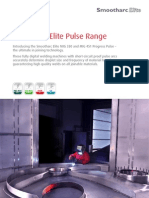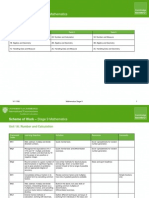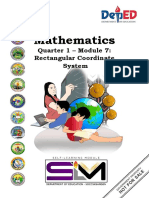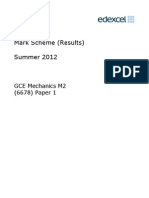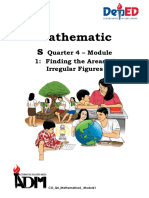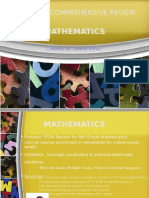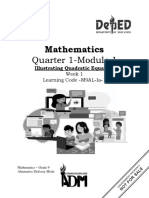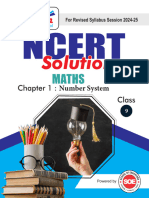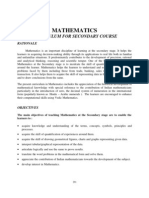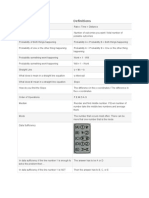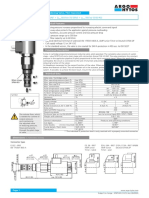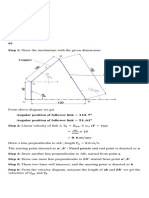Common Errors
Common Errors
Uploaded by
davrangCopyright:
Available Formats
Common Errors
Common Errors
Uploaded by
davrangOriginal Description:
Copyright
Available Formats
Share this document
Did you find this document useful?
Is this content inappropriate?
Copyright:
Available Formats
Common Errors
Common Errors
Uploaded by
davrangCopyright:
Available Formats
Mission IIT
Common Errors & How to Avoid Them
Common Errors
& How to Avoid Them
Mission IIT, Classroom Coaching Classes for IIT JEE. Suite#1, 1st Floor, SFS Market, Ashok Vihar-IV, Delhi 110052. Telephone: 27307325 E-mail: response@missioniit.com | Website: www.missioniit.com
Mission IIT
Common Errors & How to Avoid Them
Chapter: Arithmetic Progressions Type of Question - Finding Kth term from the end. Find number of terms ,given the general term find the sum of n terms Common Errors: (1) Students generally get confused by the terminology kth term from the end. Instead, they find the kth term from the beginning or they find the total number of terms and then count which term is the 10th term from last. This later method is time consuming. (2) Students also tend to confuse the nth term and n (3) Not able to decide which formula will be applicable Points to be emphasized (1) While finding the kth term from the end of an A.P., consider the A.P. in the reverse order. i.e. the new A.P. has the last term of the original A.P. as its first term and the negative of the common difference of the original A.P. as its common difference. Then find the Kth term from the beginning of the new A.P. This will be the Kth term from the end of the original A.P. For example: 10th term from end of the A.P. 4,9, 14,..254 (a = 4, d =5) is the 10th term from the beginning of the A.P.254, 249,,14,9,4 (a=254, d=-5) (2)It should be clear to you that in place of the nth term, you must put the value of the nth term. And in place of n you have to put the number of that term (3)Three things determine an AP - First term, common difference and number of terms; knowing these you can find the AP. Depending on data given, apply the appropriate formula and find the unknowns. Be careful with calculations. (4)The formula for the n-th term is
an=a1 + (n-1)d ; while, sum S of the first n values of an AP is given by S = the difference in co-efficient of a1 in both the equations.
n (2a1 + d(n-1)). Notice 2
Type of Question - Word Problems on A.P. Common Errors: (1) Students are generally not able to identify the application of Arithmetic progression in a word problem. Points to be emphasized Read the question carefully, analyse the give data. (1) If you are given an initial value which changes in a particular pattern, then
Mission IIT, Classroom Coaching Classes for IIT JEE. Suite#1, 1st Floor, SFS Market, Ashok Vihar-IV, Delhi 110052. Telephone: 27307325 E-mail: response@missioniit.com | Website: www.missioniit.com
Mission IIT
Common Errors & How to Avoid Them
you have to apply arithmetic progression to solve it. (2) For example: In a flower bed, there are 31 rose plants in the first row, 28 in the second, 25 in the third, and so on. There are 7 rose plants in the last row. How many rows are there in the flower bed? (3) In the above question, the initial value given is 31. Then the numbers of roses keep decreasing by 3 every time. This will form an A.P. with first term 31 and common difference -3. The total number of terms in the A.P. Is 7. We need to find the sum of all the terms in the A.P. Chapter: Coordinate Geometry Types of Question - Questions based on distance formula Common Mistakes (1) Error while substituting the coordinate points. Points to be emphasized In the ordered pair (a, b) order is important. Here 'a' represent x coordinate and 'b' represent y coordinate. Crosscheck whether you have correctly substituted the coordinates. Common Mistakes (1) Mistake while calculating the distance between two points. Points to be emphasized Revise the formula Do not perform many steps at a time. Solve systematically .i.e to compute distance between two points: 1.Write the formula first. 2.Substitute the values in formula. 3.Subtract 4.Square 5.Add 6.Take square root Common Mistakes Error in interpretation of the condition. 1. Vertices of right triangle 2. Vertices of square (forget to show that both the diagonals are equal) 3. Circum centre 4. Vertices of rectangle (forgets to show that angle between two sides is 900) Points to be emphasized You should know the conditions: 1. Vertices of right triangle: sides satisfy Pythagoras theorem.
Mission IIT, Classroom Coaching Classes for IIT JEE. Suite#1, 1st Floor, SFS Market, Ashok Vihar-IV, Delhi 110052. Telephone: 27307325 E-mail: response@missioniit.com | Website: www.missioniit.com
Mission IIT
Common Errors & How to Avoid Them
2. Vertices of square: All sides & both the diagonals are equal. 3. Circum centre: Distance between circum centre & point on circle is radius. 4. Vertices of rectangle: Opposite sides are equal & satisfies Pythagoras theorem (angle =90degree) Or diagonals are also equal Types of question - Questions based on section formula Common Mistakes Error in substitution
mx1 inplace of x 2 nx 2 inplace of x 1 mn my1 inplace of y 2 ny 2 inplace of y 1 mn
Points to be emphasized Remember the formula correctly. Coordinates of points P, dividing the line segment joining A(x1,y1) & B(x2,y2) internally in the ratio m:n m with point A & n with point B
On the other hand if coordinates of points P, dividing the line segment joining B(x2,y2) & A(x1,y1) internally in the ratio m:n then use
Common Mistakes Error in interpretation of the condition. Line segment bisected Line segment trisected Centroid of triangle Points to be emphasized Bisection means line segment divided into two equal parts & the coordinates of midpoints are:
x 2 x 1 y 2 y 1 , 2 2
Trisection means line segment divided into 3 equal parts (1:2 ratio) Find
Mission IIT, Classroom Coaching Classes for IIT JEE. Suite#1, 1st Floor, SFS Market, Ashok Vihar-IV, Delhi 110052. Telephone: 27307325 E-mail: response@missioniit.com | Website: www.missioniit.com
Mission IIT
Common Errors & How to Avoid Them
coordinates of point P (divided into 1:2) ratio.
Now, find coordinates of point Q by applying section formula with ratio 2:1(PB divided into 1:1 ratio by point Q Centroid of a triangle Centroid divides the median in a ratio of 2:1 & coordinates of centroid are given by:
Types of question - Area of triangle Common Mistakes 1. Forget to put
x 1x 2x 3 y 1 y 2 y3 , 2 3
Use section formula to solve such question: 1.Take ratio p : 1 and finding the ratio 2.Find the value of p
1 in the formula 2
2. Use Incorrect formula 3. Forget to take absolute value Points to be emphasized Remember the formula correctly. Compute area by: Area =
1 [x1(y2 y3) + x2(y3 y1) + x3(y1 - y2)] 2
Always remember that the coordinate points are rotating clockwise
Also area of a region is always a positive quantity and hence absolute value must be taken. So, do not worry if your answer is in the negative. But write it as the absolute value (without the negative sign). Common Mistakes Error in interpretation of condition:
Mission IIT, Classroom Coaching Classes for IIT JEE. Suite#1, 1st Floor, SFS Market, Ashok Vihar-IV, Delhi 110052. Telephone: 27307325 E-mail: response@missioniit.com | Website: www.missioniit.com
Mission IIT
Common Errors & How to Avoid Them
1. Area of a quadrilateral (Area quad ABCD =Sum of area of triangles) You should remember: To avoid confusion, For quad ABCD, Join either point A & C or B & D (not both) Compute Area of triangle separately & then add. Types of question - Short Methods Common Mistakes For proving the vertices to represent parallelogram Finding the value of k for which the three points are collinear. Proving the points to represent collinear points
Points to be emphasized
To prove that a quadrilateral with given vertices is a parallelogram using coordinate geometry, prove that the diagonals bisect each other. This can be done by finding the mid-points of the two diagonals separately and proving that both are same. If three vertices of a parallelogram are given and it is asked to find the fourth vertex, again use the fact that both the diagonals have the same mid-point. Remember that all other methods are lengthy. Students use distance formula or section formula for doing questions based on collinear points which involves lengthy calculations unless or until specified use the fact that area of triangle formed by collinear points is zero. Chapter: Surface Areas and Volumes Types of Question (i)Questions based on the surface area of combination of solids like cone, cylinder, hemisphere etc. -To find the area cost of the cloth required to make a tent in the shape of the combined solids -To find the cost of painting the surface of a vessel which is a combination of two or more solids Common Mistake (i) Misinterpreting the problem. Points to be emphasized (i) Drawing a correct figure with appropriate labels and dimensions written on it is very important. Not only it will help you to understand the problem easily but also give an idea to examiner.
Mission IIT, Classroom Coaching Classes for IIT JEE. Suite#1, 1st Floor, SFS Market, Ashok Vihar-IV, Delhi 110052. Telephone: 27307325 E-mail: response@missioniit.com | Website: www.missioniit.com
Mission IIT Common Mistake
Common Errors & How to Avoid Them
ii) Error in identifying what is to be calculated: Curved Surface Area or Total Surface Area. Points to be emphasized (ii) Remember to consider the visible surface for calculating the surface area for example let three solids Hemisphere, cylinder and cone are joined together
Here the total surface area is not the sum of total surface area of individual solids, but sum of the curved surface area of component solids. When the cloth required to make the solid is to be obtained the curved surface area of the solid is to be calculated and not the total surface area. Consider another example: Here surface area of the solid will be = CSA of the cone + base area of the cone base area of the cylinder
Common Mistake (iii) Error in identifying what needs to be calculated surface area or volume Points to be emphasized (iii) When cost of painting the solid or cloth required to make the tent is required then we need to find the surface area. If we need to find the mass of the pole, then we need to find Volume. Common Mistake (iv) Incorrect use of Formulae Points to be emphasized (iv) Remember the standard formulae of surface area and curved and total + volume of elementary solids Common Mistake (v) Not mentioning the units along with the answer Points to be emphasized (v) Write units along with answer.
Mission IIT, Classroom Coaching Classes for IIT JEE. Suite#1, 1st Floor, SFS Market, Ashok Vihar-IV, Delhi 110052. Telephone: 27307325 E-mail: response@missioniit.com | Website: www.missioniit.com
Mission IIT Common Mistake
Common Errors & How to Avoid Them
(vi) Not converting the different measurements to same units Points to be emphasized (vi) Always keep the dimensions in same measurement units. (e.g) if radius is in m and height is in cm then convert both to cms. Types of Question - A solid is melted and recast into a number of smaller solids with given dimensions. Find the number of smaller solids formed - A vessel whose dimensions are given is full of water. The water is emptied into another vessel of different shape with radius given. Find the height to which the water rises in the other vessel. Common Mistake (i) Students generally get confused whether the surface area of the big solid is equal to the SA of the smaller ones or its the volume that is equal. Points to be emphasized (i) When a solid is melted and converted to another, volume of both the solids remains the same, assuming there is no wastage in the conversions .i.e remember Volume before = volume after conversion We cant predict whether the surface area of the two solids are equal or not Common Mistake (ii) Error in considering the surface areas or the volumes of the two vessels equal Points to be emphasized (ii) Similarly when material is transferred from one solid to another, then also the volume of material in both the solids remains the same.i.e the volume of water, which is equal to the volume of the first vessel partially fills the second vessel. Hence, the volume of the first vessel is not equal to the volume of the 2nd vessel. For example: A conical vessel whose internal radius is 5 cm and height 24 cm is full of water. The water is emptied into a cylindrical vessel with internal radius 10 cm. Find the height to which the water rises in the cylindrical vessel. Here, Volume of cone = Volume of water = Volume of water in the cylinder Volume of the cylinder Common Mistake (ii) What should be taken as the value of
Mission IIT, Classroom Coaching Classes for IIT JEE. Suite#1, 1st Floor, SFS Market, Ashok Vihar-IV, Delhi 110052. Telephone: 27307325 E-mail: response@missioniit.com | Website: www.missioniit.com
Mission IIT Points to be emphasized
Common Errors & How to Avoid Them
(iii) Value of if not specified can be taken as 22/7 if radius or height are multiples of 7. Also see if you can cancel out when equating the volumes. Common Mistake (iv) calculation errors Points to be emphasized (iv) Be careful while calculating look for simplifying the things before getting in actual calculations calculate till 2 decimal places. Types of Question - A solid of given dimension is dropped in a vessel (cylinder), partly filled with water. If the solid is completely submerged in water, the water level in the vessel rises by a certain height. Find the radius of the vessel (cylinder). Common Mistake (1) Error in using the dimensions given in different units during calculations. Points to be emphasized (1) Before doing calculations, Always make the units of all dimensions uniform so as to avoid committing mistakes. Common Mistake (2) Students may consider the given height of displaced water as the total height of the water after rising by certain amount. Points to be emphasized (2) The given height of displaced water is the total height of water after rising by a certain amount the original height of water in the vessel. Common Mistake (3) Error in considering the surface area of the displaced water as equal to the surface area of the submerged solid. Points to be emphasized (3) In such questions, the volume of the displaced water is equal to the volume of the submerged solid. Not the surface area. Types of Question - Finding the metal used to make a bucket in the form of a frustum of a cone of given dimensions Also, finding the cost of the bucket if the cost of metal sheet
Mission IIT, Classroom Coaching Classes for IIT JEE. Suite#1, 1st Floor, SFS Market, Ashok Vihar-IV, Delhi 110052. Telephone: 27307325 E-mail: response@missioniit.com | Website: www.missioniit.com
Mission IIT
Common Errors & How to Avoid Them
10
used is given in rupees per 100 cm2. Common Mistake (1) Misinterpreting the question and hence finding the TSA or CSA of the frustum of the cone. Points to be emphasized 1) The metal used to make the bucket will be = CSA of frustum + area of smaller base of the frustum.
This is because, the top of the bucket is open and hence no metal is used there. So, TSA will not be calculated. The bottom of the bucket is closed and hence metal is used there. So, only CSA will not give the correct answer. Don t forget to mention the units.
Common Mistake 2) Error in calculating the cost of metal used. Points to be emphasized (2) If the rate of metal is given in Rs. 15 per 100 cm2. So if the area of metal used is calculated as 1000 cm2. Its cost will be Rs. 1000 x 15 / 100 = Rs. 150 and not Rs. 1000 x 15 Common Mistake 3) Incorrect use of formula Points to be emphasized (3) Remember the formulae.
Chapter: Statistics & Probability Types ofQuestion - Questions based on calculation of mean Common Mistakes (1) Error in formula - Forgot to write formula
Mission IIT, Classroom Coaching Classes for IIT JEE. Suite#1, 1st Floor, SFS Market, Ashok Vihar-IV, Delhi 110052. Telephone: 27307325 E-mail: response@missioniit.com | Website: www.missioniit.com
Mission IIT Points to be emphasized
Common Errors & How to Avoid Them
11
Remember and write the correct formula while answering the questions on arithmetic mean. Common Mistakes Calculation mistakes in finding fixi & sum of fixi Points to be emphasized Use the method specified in the question or otherwise choose the appropriate method by carefully observing the figures given. Common Mistakes Not using the specified method Points to be emphasized If the values are large and all dis have a common factor, use step deviation method. Calculate upto two decimal places Common Mistakes (1) Calculation mistake while finding the missing frequencies Points to be emphasized Remember that only like terms can be combined. Common Mistakes (2) Add the value of p along with the data e.g. 250+10p = 260p Points to be emphasized While finding the sum you should add the unknown frequency with known frequency. Common Mistakes (3) Multiply f while finding the sum of frequency(fi) & fixi Points to be emphasized Calculate upto two decimal places Types of Question - Question based on mode
Mission IIT, Classroom Coaching Classes for IIT JEE. Suite#1, 1st Floor, SFS Market, Ashok Vihar-IV, Delhi 110052. Telephone: 27307325 E-mail: response@missioniit.com | Website: www.missioniit.com
Mission IIT Common Mistakes
Common Errors & How to Avoid Them
12
(1) Forget to write the formula (2) Error in writing the formula (3) Substituting wrong values of f0, f1, f2 Points to be emphasized Remember the correct formula : For grouped frequency distribution Mode = +
f 1 f 0 2f 1 f 0 f 2
xh
f0: frequency of the class preceding the modal class f1: frequency of modal class f2: frequency of class succeeding the modal class : Lower limit of modal class h: class size Now remember that f1 is the frequency of the modal class 0 comes before 1 so fo is the frequency of previous class and 2 comes after 1so the frequency of next class. Types of Question - Questions based on Median Common Mistakes (1) Forget to write the formula (2) Error in identification of median class (3) Substitute the cumulative frequency of median class in place of cumulative frequency of preceding class. Substitute incorrect frequency in place of frequency of median class. (4) Error in converting less than and more than data types to standard frequency tables Points to be emphasized (1) Identifying the median class is of prime importance to these questions as the whole formula depends on that. (2) Convert less than and more than type distribution carefully (3) Remember the formula and the terminologies correctly For grouped data Now find median class by locating the class whose cumulative frequency is
Mission IIT, Classroom Coaching Classes for IIT JEE. Suite#1, 1st Floor, SFS Market, Ashok Vihar-IV, Delhi 110052. Telephone: 27307325 E-mail: response@missioniit.com | Website: www.missioniit.com
Mission IIT greater than ( and nearest to )
Common Errors & How to Avoid Them
13
n 2
cf: cumulative frequency of class preceding the median class f: frequency of the median class : lower limit of median class h: class size Types ofQuestion - Questions based on represent in g the cumulative frequency distribution graphically Common Mistakes Error in representation of curve (1) Join the points of the curve with ruler (scale) (2) Forget to write the quantities represented on the horizontal & vertical axis. (3) Error while plotting the respective points. Points to be emphasized (1) Join all the points of the curve with free hand (smooth curve). (2) Mark the upper limit/ lower limit of the class interval on the horizontal (x axis) & their corresponding cumulative frequencies on the vertical axis (y axis) (3) Plot the lower/upper limit with their corresponding frequencies (4) Quick points to determine whether the curve is less than ogive or more than ogive Less than ogive 1. Upper limit represented on x axis 2. Rising curve 3. Values of cumulative frequency would decrease with increasing values of upper limit More than ogive 1. Lower limit represented on y axis 2. Fall in curve 3. Values of cumulative frequency would increase with increasing values of lower limit.
(5) The median of grouped data is the x coordinate of the point of intersection of less than & more than ogive (6) Practise questions Common Mistakes (1) Forget to compute the cumulative frequency
Mission IIT, Classroom Coaching Classes for IIT JEE. Suite#1, 1st Floor, SFS Market, Ashok Vihar-IV, Delhi 110052. Telephone: 27307325 E-mail: response@missioniit.com | Website: www.missioniit.com
Mission IIT (2) Calculation mistake Points to be emphasized
Common Errors & How to Avoid Them
14
(1) The first step is to compute the cumulative frequency then only you can comment on nature of curve. (2) Double check after finding the corresponding cumulative frequency. (3) Practise questions Types ofQuestion - Questions based finding the Probability Common Mistakes (1) Dont write the total outcomes of the event (2) Forget to write the formula (3) Error while counting of outcomes in case of cards e.g. in case of cards numbered from 15 to 30, they count it as 15 instead of 16 Points to be emphasized (1) Write total outcomes, favourable outcomes, the formula and then calculate the probability (2) For card questions remember the card type split up.
Mission IIT, Classroom Coaching Classes for IIT JEE. Suite#1, 1st Floor, SFS Market, Ashok Vihar-IV, Delhi 110052. Telephone: 27307325 E-mail: response@missioniit.com | Website: www.missioniit.com
Mission IIT
Common Errors & How to Avoid Them
15
NOTES
Mission IIT, Classroom Coaching Classes for IIT JEE. Suite#1, 1st Floor, SFS Market, Ashok Vihar-IV, Delhi 110052. Telephone: 27307325 E-mail: response@missioniit.com | Website: www.missioniit.com
Mission IIT
Common Errors & How to Avoid Them
16
Mission IIT, Classroom Coaching Classes for IIT JEE. Suite#1, 1st Floor, SFS Market, Ashok Vihar-IV, Delhi 110052. Telephone: 27307325 E-mail: response@missioniit.com | Website: www.missioniit.com
You might also like
- IB Grade 9 Math Book-Chapter1Document36 pagesIB Grade 9 Math Book-Chapter1aa1cc276% (25)
- O Level Revision Guide TableDocument1 pageO Level Revision Guide TableDaud Farzand KhokharNo ratings yet
- File 2 10Document8 pagesFile 2 10camelod555No ratings yet
- CBSE Class 5 Mathematics Question Paper Set CDocument2 pagesCBSE Class 5 Mathematics Question Paper Set CKAMALESH KUMAR SINGH100% (4)
- Engineering Economy Lecture4Document22 pagesEngineering Economy Lecture4Jaed Caraig0% (2)
- Tutorial Letter 201 Ass AnsDocument4 pagesTutorial Letter 201 Ass Anssumaya20% (5)
- PST201F: Tutorial Letter 201/1/2014Document10 pagesPST201F: Tutorial Letter 201/1/2014Lifalakhe Daryl NkosiNo ratings yet
- Tutorial Letter 201/1/2012: PST201FDocument10 pagesTutorial Letter 201/1/2012: PST201FAshanti Gaby Phillips100% (1)
- 15 Tips To Cheat at MCQs in IIT JEEDocument8 pages15 Tips To Cheat at MCQs in IIT JEESomrat DuttaNo ratings yet
- Sequences and Series ScenariosDocument9 pagesSequences and Series ScenariosManisah Mohd ShahNo ratings yet
- Module 3 GR 12Document22 pagesModule 3 GR 12WilmerNo ratings yet
- Math 1172 Sample Midterm 3 Form ADocument11 pagesMath 1172 Sample Midterm 3 Form AKevin UnkrichNo ratings yet
- Strategy For Improvement of Mathematics Result Class X BY: Academic Support GroupDocument48 pagesStrategy For Improvement of Mathematics Result Class X BY: Academic Support GroupitsankurzNo ratings yet
- 10 MathDocument6 pages10 MathHannah Loth ExceliseNo ratings yet
- Scheme of Work Maths Stage 9Document16 pagesScheme of Work Maths Stage 9Sue Adames de Velasco50% (2)
- ParallelogramDocument25 pagesParallelogramayunugebreNo ratings yet
- SMAW NC I (Module 3 Common) Perform Industry CalculationDocument10 pagesSMAW NC I (Module 3 Common) Perform Industry CalculationCelso Amoto100% (1)
- To The Extent of 5 MarksDocument17 pagesTo The Extent of 5 Marksapi-243565143No ratings yet
- MATH 1342 Elementary Statistics Prerequisite ReviewDocument8 pagesMATH 1342 Elementary Statistics Prerequisite ReviewAnaNo ratings yet
- Mathematics: Quarter 1 - Module 7: Rectangular Coordinate SystemDocument20 pagesMathematics: Quarter 1 - Module 7: Rectangular Coordinate SystemAngellee BatolanonNo ratings yet
- Week 1-1 Basic Concepts of Geometry 2023-2024Document72 pagesWeek 1-1 Basic Concepts of Geometry 2023-2024mary.hernandez003No ratings yet
- Mark Scheme (Results) Summer 2012: GCE Mechanics M2 (6678) Paper 1Document16 pagesMark Scheme (Results) Summer 2012: GCE Mechanics M2 (6678) Paper 1Romel BhaiNo ratings yet
- Math4 Q4 Mod1 FindingTheAreaOfIrregularFigure V4Document19 pagesMath4 Q4 Mod1 FindingTheAreaOfIrregularFigure V4Gina HerraduraNo ratings yet
- Examinerreport Unit1 (WMA11) October2020Document8 pagesExaminerreport Unit1 (WMA11) October2020Mohammed Al RaeesiNo ratings yet
- Ccgps Algebra Eoct Handout - With SolutionsDocument29 pagesCcgps Algebra Eoct Handout - With SolutionsRyan JoshivlogsNo ratings yet
- Math10 q2 Mod8of8 Graph of Circle and Other Geometric Figures v2Document15 pagesMath10 q2 Mod8of8 Graph of Circle and Other Geometric Figures v2Ledesma, Elijah O.100% (1)
- Examinerreport Paper1 January2012Document12 pagesExaminerreport Paper1 January2012Arnob MridhaNo ratings yet
- Resonance Kota Class 9 Mathematics BookDocument320 pagesResonance Kota Class 9 Mathematics Bookdashmesh.bhatia.12350% (2)
- Promaths Final Push Paper 2 Paper 2 (October 2023)Document144 pagesPromaths Final Push Paper 2 Paper 2 (October 2023)thatohatsihlohonolofatsoNo ratings yet
- 1999 Math NC PDFDocument4 pages1999 Math NC PDFPoulastha MukherjeeNo ratings yet
- Grade 8 Math Review 1Document61 pagesGrade 8 Math Review 1api-359949059No ratings yet
- Math9 Q1 Weeks5to8 Binded Ver1.0-1Document41 pagesMath9 Q1 Weeks5to8 Binded Ver1.0-1jayiaNo ratings yet
- 10th (E) Revision PaperDocument68 pages10th (E) Revision PaperHarish KumarNo ratings yet
- MathDocument179 pagesMathFaziyana Busu Nollah100% (1)
- Quarter 1-Module 1: MathematicsDocument13 pagesQuarter 1-Module 1: MathematicsZL TenorioNo ratings yet
- New Budget of Work in Mathematics For Grade FiveDocument8 pagesNew Budget of Work in Mathematics For Grade FivesweetienasexypaNo ratings yet
- Lesson Plan About Irrational Numbers Grade 7Document4 pagesLesson Plan About Irrational Numbers Grade 7Alicarte Ann100% (1)
- New Budget of Work in Mathematics For Grade FiveDocument8 pagesNew Budget of Work in Mathematics For Grade FiveAnonymous yIlaBBQQ100% (1)
- 8ph0 02 Ms Nov 2021 Edexcel As PhysicsDocument19 pages8ph0 02 Ms Nov 2021 Edexcel As PhysicssenseiNo ratings yet
- The Formula For Solving The Square of A Two-Digit Number Ending in 5 (2D-5 Formula)Document8 pagesThe Formula For Solving The Square of A Two-Digit Number Ending in 5 (2D-5 Formula)Iris Joy Basquial AquinoNo ratings yet
- 6667 01 MSC 20150812Document16 pages6667 01 MSC 20150812Mozammel AnowarNo ratings yet
- Measurement - Area RevisionDocument18 pagesMeasurement - Area RevisionJMoNo ratings yet
- Sequences and Series Take Home Test 2015Document5 pagesSequences and Series Take Home Test 2015francel floresNo ratings yet
- Class 9 Mathematics NCERT Solution Chapter 1 Number SystemDocument42 pagesClass 9 Mathematics NCERT Solution Chapter 1 Number SystemArtham ResourcesNo ratings yet
- Technology Integrated Lesson FRIT 8530Document15 pagesTechnology Integrated Lesson FRIT 8530ameotiaNo ratings yet
- Mathematics 8: Quarter 3 - Module 6: Solving Congruent Triangles and Its ApplicationDocument24 pagesMathematics 8: Quarter 3 - Module 6: Solving Congruent Triangles and Its ApplicationKuya Kusinero0% (2)
- Learning Plan - IntegersDocument15 pagesLearning Plan - IntegersWilliam Mhae Flores Co100% (1)
- Class 9th MathsDocument324 pagesClass 9th MathsI AM KIM TAEHYUNG0% (1)
- ADM G8 Q4 Week1 Week4Document33 pagesADM G8 Q4 Week1 Week4Jp Pineda MedinaNo ratings yet
- Permutations and CombinationsDocument65 pagesPermutations and Combinationsgilbertelena7898No ratings yet
- Permutation and Combination TheoryDocument31 pagesPermutation and Combination TheoryYash Raj100% (2)
- Mathematics: Curriculum For Secondary CourseDocument11 pagesMathematics: Curriculum For Secondary CourseGOYALA85No ratings yet
- Math8 - q1 - Mod2 - Solving Problems Involving Factors of Polynomials - 08092020Document22 pagesMath8 - q1 - Mod2 - Solving Problems Involving Factors of Polynomials - 08092020Cassandra Nicole FranciscoNo ratings yet
- Permutation and Combination 33rqKjvDocument33 pagesPermutation and Combination 33rqKjvツ-AtharvNo ratings yet
- Guided Noteboo Kin GED10 2 (Mathe Matics in The Modern World)Document6 pagesGuided Noteboo Kin GED10 2 (Mathe Matics in The Modern World)Aaronie DeguNo ratings yet
- SML-SET 1-Batch 1-Answer KeyDocument8 pagesSML-SET 1-Batch 1-Answer Keybi1103No ratings yet
- Mathematics: Quarter 1 - Module 5: Solving Problems Involving SequenceDocument20 pagesMathematics: Quarter 1 - Module 5: Solving Problems Involving SequenceSherwin G Serrano100% (1)
- Area of Composite Figures - Detailed Methods and Practice ProblemsDocument2 pagesArea of Composite Figures - Detailed Methods and Practice Problems连瑾No ratings yet
- GMAT MathsDocument24 pagesGMAT MathsNayyar MuhammadNo ratings yet
- High School Lesson Plan With SELDocument4 pagesHigh School Lesson Plan With SELXavier SánchezNo ratings yet
- SPM Mathematics PresentationDocument30 pagesSPM Mathematics PresentationKnk Resources CornerNo ratings yet
- Master Fundamental Concepts of Math Olympiad: Maths, #1From EverandMaster Fundamental Concepts of Math Olympiad: Maths, #1No ratings yet
- BCA Tracker Instructional GuideDocument7 pagesBCA Tracker Instructional GuidedavrangNo ratings yet
- My Lab My Lab Best Practices and Tips: Math / StatDocument7 pagesMy Lab My Lab Best Practices and Tips: Math / StatdavrangNo ratings yet
- AnswersDocument14 pagesAnswersguusjuh2No ratings yet
- Food Science IntroductionDocument25 pagesFood Science IntroductionFederico LeonNo ratings yet
- Ipcc BrochureDocument12 pagesIpcc BrochuredavrangNo ratings yet
- Elimination MethodsDocument58 pagesElimination MethodsmanankNo ratings yet
- 32348812-001 II DLS4IM DALI-Interface-ModuleDocument2 pages32348812-001 II DLS4IM DALI-Interface-ModuleAnonymous XYAPaxjbYNo ratings yet
- Notes-PPT - BE - EV - Sem I - Unit 5 - Frame - Chassis DesignDocument57 pagesNotes-PPT - BE - EV - Sem I - Unit 5 - Frame - Chassis DesignTEA74 Omkar walunj100% (1)
- Reassessment of Expectations As A Comparison Standard in Measuring Service Quality - Implications of Future ResearchDocument15 pagesReassessment of Expectations As A Comparison Standard in Measuring Service Quality - Implications of Future ResearchTembelistikaNo ratings yet
- Chapter 1 Unit 1 Brock Biology of Microorganisms, Ebook, Global EditionDocument37 pagesChapter 1 Unit 1 Brock Biology of Microorganisms, Ebook, Global Edition22063 - Trần Chí HiệpNo ratings yet
- Stock Valuation FormulasDocument2 pagesStock Valuation FormulasEliseNo ratings yet
- Baq Ils y Rwy 05 PDFDocument1 pageBaq Ils y Rwy 05 PDFAlexandra DiazNo ratings yet
- A5984 DatasheetDocument28 pagesA5984 DatasheetIndraz NilNo ratings yet
- GSLB LogDocument74 pagesGSLB LogKamal SalmarNo ratings yet
- UX Guide To Uxdesign Process and Documentation PDFDocument104 pagesUX Guide To Uxdesign Process and Documentation PDFArthur AefNo ratings yet
- Getting Started With Revit ArchitectureDocument48 pagesGetting Started With Revit ArchitectureAljosa Nikolic100% (2)
- P8 Shortcut - KeysDocument3 pagesP8 Shortcut - KeysAlisha AnsariNo ratings yet
- Sap Odata Services: AtozofDocument24 pagesSap Odata Services: Atozofjeetendra TNo ratings yet
- Tooth MorphologyDocument8 pagesTooth MorphologyMuhammad Haseeb Amjad100% (1)
- SP4P2-B3: Proportional Pressure Reducing - Relieving Valve, Pilot OperatedDocument2 pagesSP4P2-B3: Proportional Pressure Reducing - Relieving Valve, Pilot OperatedДима ПолищукNo ratings yet
- Dop 10076 Paroc Extra en UsDocument2 pagesDop 10076 Paroc Extra en UsJānis DimantsNo ratings yet
- Troubleshooting The Divider Block SystemDocument3 pagesTroubleshooting The Divider Block SystemMarcus MorganNo ratings yet
- Zinc Acetate Oral SolutionDocument1 pageZinc Acetate Oral SolutionKasidit SornchaiNo ratings yet
- Control Logic Ir Flame Detector RIV-601P/FDocument1 pageControl Logic Ir Flame Detector RIV-601P/FPrataban UNo ratings yet
- LON-Developement Guideline-250723-150538Document2 pagesLON-Developement Guideline-250723-150538oscarnoe21No ratings yet
- IMMUNOLOGICAL AND BIOCHEMICAL RESPONSE FROM OLDER ADULTS WITH URINARY TRACT INFECTION TO UROPATHOGENIC Escherichia Coli VIRULENCE FACTORSDocument5 pagesIMMUNOLOGICAL AND BIOCHEMICAL RESPONSE FROM OLDER ADULTS WITH URINARY TRACT INFECTION TO UROPATHOGENIC Escherichia Coli VIRULENCE FACTORSjavelezhNo ratings yet
- Conductivity Type Level Switch: Salient FeaturesDocument2 pagesConductivity Type Level Switch: Salient FeaturesY YubtNo ratings yet
- Four Bar LinkageDocument3 pagesFour Bar LinkageFarhanNo ratings yet
- Mini Project FormatDocument7 pagesMini Project FormatVivek SinghNo ratings yet
- Spark RecoveryDocument2 pagesSpark RecoveryluciusmonaNo ratings yet
- CL Relationships Matter SeDocument16 pagesCL Relationships Matter Seapi-261894355No ratings yet
- A Review Paper On Cryptographic Hash FunctionDocument11 pagesA Review Paper On Cryptographic Hash Functionhamid khanNo ratings yet


